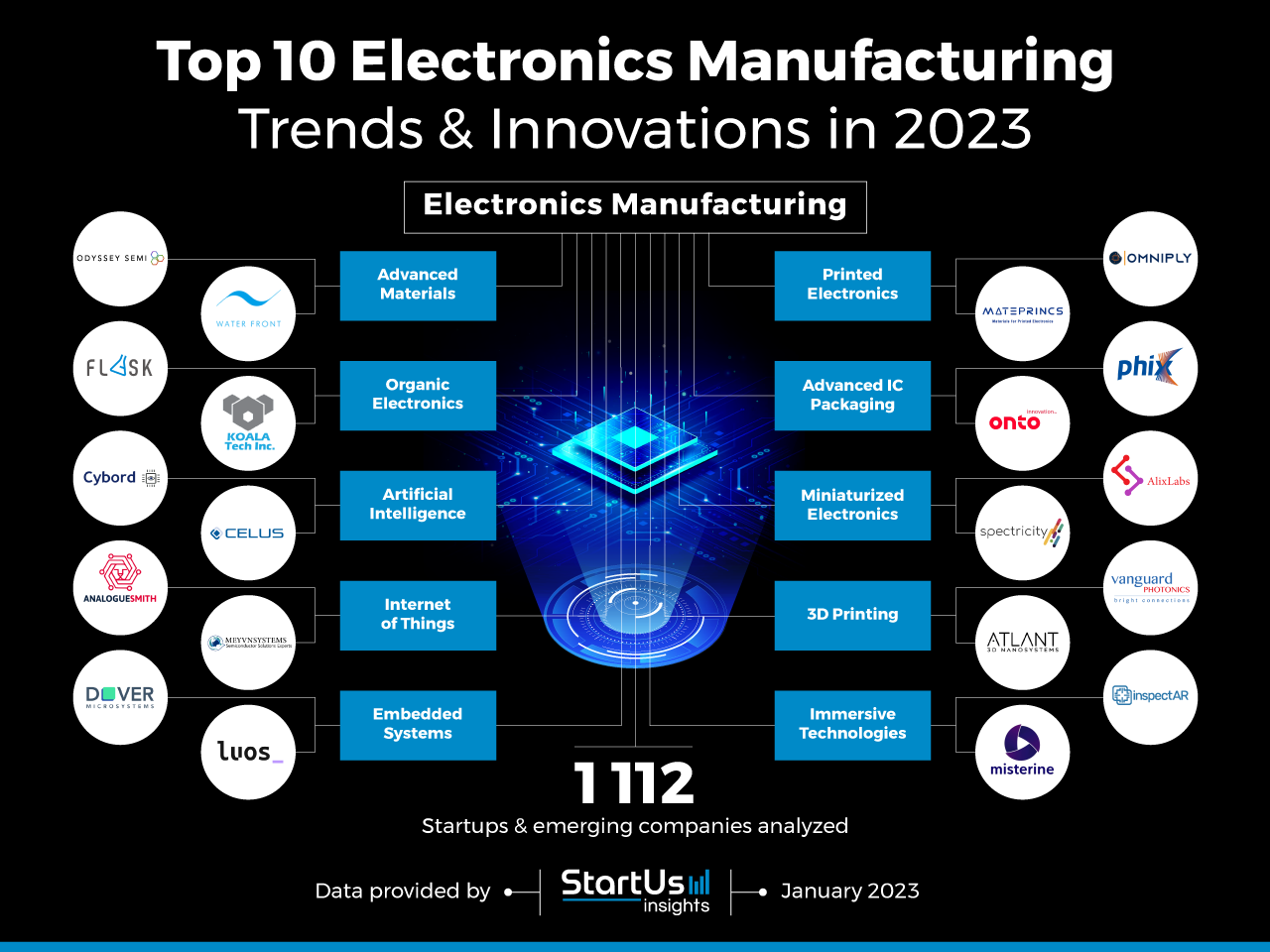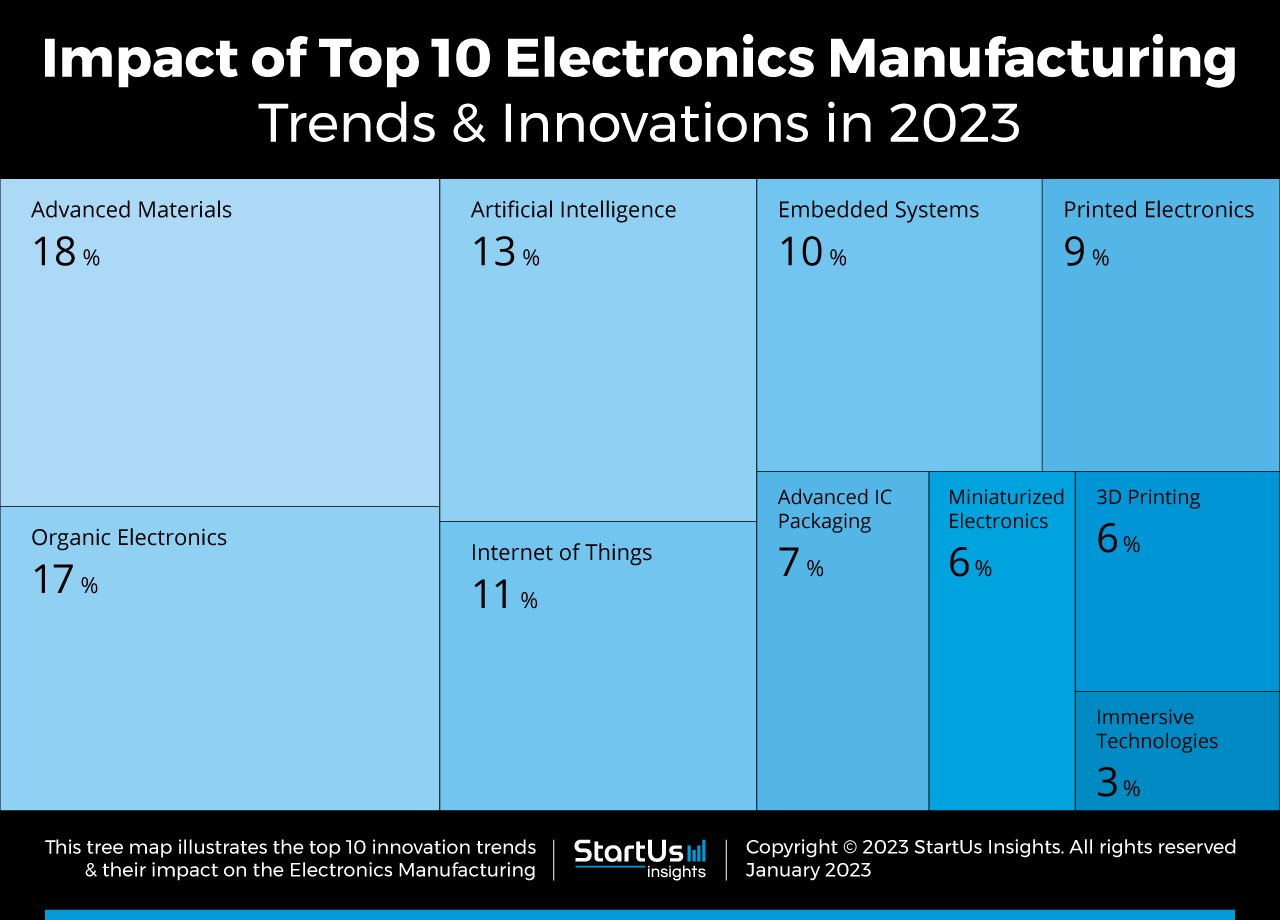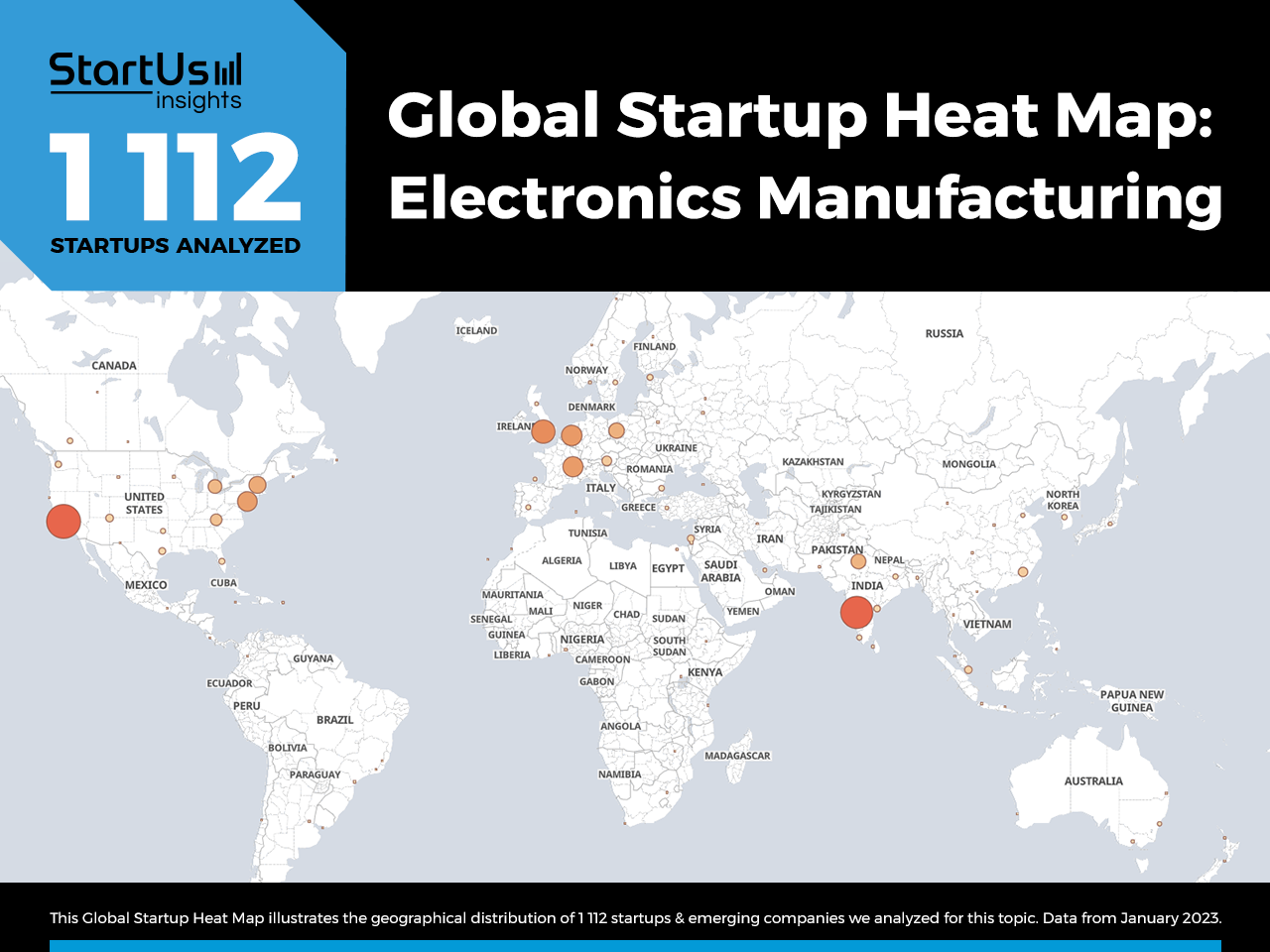The electronics manufacturing industry expands, leveraging advanced materials, organic electronics, and miniaturization. Key trends include AI and IoT for smart manufacturing and industry growth. Startups innovate in component design and manufacturing for efficiency and compatibility, while 3D printing enhances the industry’s dynamism and cost-effectiveness. These trends improve the efficiency, durability, and sustainability of electronics.
This article was last updated in July 2024.
Innovation Map outlines the Top 10 Electronics Industry Trends & 20 Promising Startups
For this in-depth research on the Top Electronics Manufacturing Trends & Startups, we analyzed a sample of 1112 global startups & scaleups. This data-driven research provides innovation intelligence that helps you improve strategic decision-making by giving you an overview of emerging technologies in the electronics manufacturing industry. In the Electronics Manufacturing Innovation Map, you get a comprehensive overview of the innovation trends & startups that impact your company.
10 Emerging Electronics Industry Trends in 2025
- Advanced Electronic Materials
- Organic Electronics
- Artificial Intelligence
- Internet of Things
- Embedded Systems
- Printed Electronics
- Advanced IC Packaging
- Miniaturized Electronics
- 3D Printing
- Immersive Technologies

Want to explore all Electronics innovations & trends?
These insights are derived by working with our Big Data & Artificial Intelligence-powered StartUs Insights Discovery Platform, covering 4.7M+ startups & scaleups globally. As the world’s largest resource for data on emerging companies, the SaaS platform enables you to identify relevant technologies and industry trends quickly & exhaustively.
Tree Map reveals the Impact of the Top 10 Trends in the Electronics Industry
Based on the Electronics Innovation Map, the Tree Map below illustrates the impact of the Top 10 Electronics Engineering Technology Trends in 2025. Advanced materials are required for the fabrication process as common semiconductor materials are unable to achieve miniaturization and sustainability. Similarly, organic electronics address global concerns about sustainability and eco-friendly manufacturing. Electronics manufacturing startups employ AI and IoT in the designing and fabrication processes.
Further, advanced circuit packaging reduces the size of a chip every year and integrates more and more functions. Because of the growing demand for flexibility and customization of embedded systems, startups work on new system architectures and designs. Technologies enabling printed electronics are also gaining traction and 3D printing is gathering a lot more attention due to its decentralized production and rapid prototyping capabilities.
Global Startup Heat Map covers 1112 Electronics Manufacturing Startups & Scaleups
The Global Startup Heat Map below highlights the global distribution of the 1112 exemplary startups & scaleups that we analyzed for this research. Created through the StartUs Insights Discovery Platform, the Heat Map reveals high startup activity in the US, followed by India and Europe. Below, you get to meet 20 out of these 1112 promising startups & scaleups as well as the solutions they develop. These electronics startups are hand-picked based on criteria such as founding year, location, funding raised, & more. Depending on your specific needs, your top picks might look entirely different.
Top 10 Electronics Technology Trends in 2025
1. Advanced Electronic Materials
The semiconductor industry has been reliant on silicon for decades, but there is a limit to how far you can etch, lithograph, and pattern a silicon material. As a result, innovation to increase the performance of integrated circuits is coming from new materials and architectures.
Startups and scaleups are developing silicon alternatives and other semiconductor materials or composites such as graphene and nanomaterials for high performance and efficiency.
Odyssey Semiconductor develops Gallium Nitride (GaN) Semiconductor Material
US-based startup Odyssey Semiconductor builds high-performance power-switching gallium nitride (GaN) semiconductor material. Its GaN processing technology allows for the realization of vertical current conduction GaN devices which extend application voltages from 1000V to over 10 000V.
It extends well beyond the consumer electronics application and into applications such as electric vehicles (EVs), industrial motor control, and energy grid applications.
SixLine Semiconductor commercializes Carbon Nanotube Processing
SixLine Semiconductor is a US-based startup that advances carbon nanotube processing. The startup manufactures semiconductor-grade carbon nanotubes that support room-temperature deposition on any substrate. Its technology features high packing density, tight alignment, high-throughput processing, and selective deposition.
The startup’s solution enables electronics manufacturers to mass produce high-performance transistor channels and finds use in manufacturing wireless, computing, and sensor components.
2. Organic Electronics
Organic Electronics offer massive advantages over traditional inorganic electronics. They are cost-effective, flexible, indissoluble, optically transparent, lightweight, and consume low power. In addition, the rise in awareness of sustainable development and eco-friendly manufacturing attracts manufacturers to opt for organic electronics. Designing circuits with microbial components or producing devices with biodegradable and recyclable materials is seen to be the next electronics manufacturing trend.
Moreover, the application of organic materials to manufacture electronic devices enables electronics manufacturers to use safer, fewer, and more abundantly available raw materials. Hence, it creates new business opportunities for companies and this is sure to give them a competitive edge in the long run.
Flask offers Materials for Organic Electronics Devices
Japanese startup Flask develops materials for application in various products such as organic displays, lighting, and solar cells. Examples of materials include electron transport materials, electron injection materials, light-emitting materials, coating materials, and organic solar cell materials.
Using these materials allows device manufacturers to meet customer demands like high efficiency, low power consumption, high reliability, and adaptation to next-generation materials.
Koala Tech develops Organic Semiconductor Laser Diode
Japanese startup Koala Tech develops an organic semiconductor laser diode. The startup’s laser diode technology is based on organic fluorescent semiconductors, which are generally easier, less harmful, and faster to process into thin films.
It enables manufacturers to use a low-cost light source that easily integrates into OLED and organic electronic platforms.
3. Artificial Intelligence
AI-powered solutions are gaining popularity in every sector. AI impacts the growth of semiconductor manufacturing in two ways, one by building demand for innovative AI-capable electronics components, and two, by enhancing the product manufacturing and design processes. The conventional methods have limitations in reshaping product development cycles, improving product design processes, and reducing defects. But the application of AI is solving all these limitations.
The implementation of predictive maintenance in the production lines also allows manufacturers to reduce downtime. Hence, artificial intelligence is one of the most important technologies among the electronics manufacturing trends.
Cybord develops AI-based Component Inspection Software
Israeli startup Cybord offers AI-based component inspection software. The startup uses visual inspection technology powered by artificial intelligence to achieve this. It is capable of doing material sourcing, manufacturing, and defect management of individual components and the assembled product as a whole.
Implementing this software in manufacturing facilities enables electronics companies to assure that each and every assembled component is genuine and untampered.
Celus offers an AI-powered Engineering Platform
German startup Celus creates an AI-powered engineering platform to automate all the manual steps in the engineering process. The startup’s platform automatically finds fitting components with the components’ information blocks available in the engineering platform. It then designs and generates schematics and PCB-floor planning with a single click.
The platform is also designed to fully integrate into an existing electronics manufacturing environment and automate the process from concept to design. In general, it allows manufacturers to reduce product development times and complexity in the development process.
4. Internet of Things
The rapid growth of the Internet of Things represents an unprecedented opportunity for the IoT electronics manufacturing industry. It re-evaluates the fabrication process and manages practices that are found to be difficult to achieve with conventional approaches. In other ways, the IoT enables electronic manufacturing machines to self-process and store data while being digitally connected.
Continuous improvements in the fabrication of sensors are also required since sensors are the key components that enable IoT applications. Further, the transition to 5G-enabled devices requires flawless, innovative chips with more efficient architectures at lower costs.
AnalogueSmith develops Integrated Circuit for IoT Sensor Nodes
Singaporean startup AnalogueSmith specializes in integrated circuit design for IoT sensor nodes. The startup offers complementary metal-oxide-semiconductor (CMOS)-based integration of RF, analog, and digital functionality for integrated circuits.
This CMOS-based approach allows manufacturers to reduce costs without compromising on performance requirements.
Meyvnsystems offers IoT Communication Systems
Singaporean startup Meyvnsystems develops wireless communication systems for IoT devices. The startup offers LTE Cat-M, NB-IoT, wireless LAN, Bluetooth, and 5G systems based on communication distance, power consumption, and data throughput requirements.
This allows IoT manufacturers to mitigate in-house communication system design and reduce development periods.
5. Embedded Systems
Embedded systems are an unavoidable part of any electronic device nowadays and it has a crucial role in deciding the speed, security, size, and power of the devices. Since we are in the transition phase of a connected world, there is high demand for embedded systems.
So the designing and manufacturing sector of such systems is undergoing numerous innovations to improve performance, security, and connectivity capabilities. Further, in electronics manufacturing facilities, these systems are useful for increasing machine control and monitoring.
Dover Microsystems develops Processor Level Security Solutions
US-based startup Dover Microsystems offers security solutions in protecting devices against network-based attacks at the processor level. The startup’s hardware-based technology guards the host processor by monitoring and screening every instruction executed based on a set of security, safety, and privacy rules.
In this way, it empowers processors to protect themselves in real-time from the exploitation of software vulnerabilities. Hence, integrating this technology within embedded systems enables manufacturers to solve the challenges associated with device security.
Luos provides Open-Source and Real-Time Orchestrator for Distributed Architectures
French startup Luos develops an open-source and real-time orchestrator for distributed architectures to easily design, test, and deploy embedded applications. The startup’s solution encapsulates hardware and software functions as microservices.
So, each microcontroller communicates with and recognizes one other, but remains independent of each other. Further, the startup offers a reusable configuration profile and offers more flexibility in the hardware development cycle.
6. Printed Electronics
Printing electronic components on a semiconductor substrate is the most effective way to reduce the overall cost of the manufacturing process. So, manufacturers are always trying to tackle this challenge by searching for new technologies and advancements in conventional printing technologies.
Unlike traditional semiconductors that use tiny wires as circuits, 3D-printed electronics rely on conductive inks and often flexible films. Further, the advancements in printing technologies allow the flexible hybrid electronics field to obtain enough momentum. Therefore, startups and scaleups are developing solutions for advanced printing technologies.
Omniply develops a Delamination Technique for Printed Electronics
Canadian startup Omniply offers a delamination technology that facilitates the separation of flexible circuits from their rigid carrier. It creates high-performance electronic devices on flexible substrates without compromising device performance or without changing the manufacturing infrastructure.
This delamination technique makes the process cheaper and eco-friendly, compared to traditional delamination methods. In addition, it overcomes resolution and reliability limits associated with printed electronics by using traditional CMOS infrastructure for device fabrication.
TracXon advances Circular & Hybrid Printed Electronics (HPE)
TracXon is a Dutch startup that makes sustainable and hybrid printed electronics. The startup leverages sheet-to-sheet (S2S) and roll-to-roll (R2R) printing, photonic sintering, stencil printing, component assembly, and more to make printed electronics.
The startup’s technology also features a lower carbon footprint and finds applications in the lighting, automotive, healthcare, and electronics industries.
7. Advanced IC Packaging
In recent years, chip packaging has become a hot topic along with chip design. The traditional way to scale a device based on Moore’s law has limitations nowadays. The other way to get the benefits of scaling is to put multiple complex devices in an advanced package. So, semiconductor manufacturers develop new advanced IC packaging technologies to provide greater silicon integration in increasingly miniaturized packages.
The startup also enables manufacturers to offer customization and improve yields by vertically stacking modular components. Besides, advanced IC packaging optimizes manufacturing to balance customer needs against overall costs.
PHIX offers Photonic Integrated Circuit (PIC) Assembly and Packaging
Dutch startup PHIX provides assembly and packaging services for photonic integrated circuits. To make PICs a part of a photonics-enabled module, it needs to be connected to components like optical fibers, other PICs, cooling solutions, and electronics.
The startup designs and manufactures the package in which these connections are made. PHIX allows the semiconductor industry to optimize the PIC and module design, process, and equipment, as well as scale up production.
Onto Innovation develops Advanced IC Packaging Equipment
US-based startup Onto Innovation builds equipment for advanced packaging processes for the semiconductor industry. The startup’s solution, JetStep W2300 System, features specialized large field optics and key system advantages to deliver maximum throughput without limiting resolution.
The startup enables electronics manufacturers to tackle IC packaging challenges along with device performance, quality, and reliability issues.
8. Miniaturized Electronics
Miniaturization enabled the use of electronics in several novel application areas. Particularly, healthcare and automotive industry applications have space limitations in terms of implementing specific devices. Previously, the miniaturization concept was limited by their practical handling, display, and battery, but not by the built-in electronics.
There are innovations happening to make electronic components as small as possible by maintaining speed, reliability, and efficiency. Another important aspect of miniaturization is the integration of more and more features into a single component. For example, nanonet sensors and forksheet FET are a couple of recent developments in miniaturized electronic components.
Alixlabs offers an ALE-Based Method of Manufacturing Nanostructures
Swedish startup AlixLabs provides an atomic layer etching (ALE)-based method for manufacturing nanostructures with a characteristic size below 20 nm. The startup’s technology achieves nanostructure fabrication beyond the resolution limit for optical and electron beam lithography.
The startup also enables an economically affordable way of transistor channel scaling for sub-20 nm technology nodes. Further, this allows for a higher level of device integration, in turn, reducing costs, increasing speed, and lowering the energy consumption of devices.
Spectricity provides Spectral Sensing Solutions
Belgian startup Spectricity develops miniaturized integrated spectral sensing solutions. The startup’s patented wafer-scale hyperspectral filter technology, combined with CMOS integration processes, results in miniaturized sensors.
Unlike other solutions, its filters do not require complex and bulky optics or packaging, slow scanning, or sophisticated calibration. Hence, it produces sensing devices compatible with the size, power consumption, and cost requirements of mobile devices.
9. 3D Printing
Additive manufacturing in the electronics industry eliminates the need for flat circuit boards. It enables new innovative designs and shapes that cannot be produced through conventional means. 3D printers also fabricate electronic components as a single, continuous part, effectively creating fully functional electronics that require little or no assembly.
Consequently, the implementation of this electronics manufacturing trend speeds up prototyping, offers mass customization, and decentralizes parts production. In general, 3D printing technology made possible electronic components production in terms of 3D design and not only 2D, with new ways of stacking the circuits.
Vanguard Photonics provides 3D Nanofabrication for Photonic Integration
German startup Vanguard Photonics offers 3D nanofabrication for photonic integration. The startup’s technology overcomes key challenges of large-scale photonic integration and system assembly by enabling in situ printing of facet-attached beam-shaping elements.
The technology also enables precise adaptation of vastly dissimilar mode profiles and permits alignment tolerances compatible with cost-efficient passive assembly techniques. The startup automates the assembly of photonic multi-chip systems with high performance and versatility.
ATLANT 3D Nanosystems offers Atomic Layer 3D Printing Technology
Danish startup ATLANT 3D Nanosystems develops atomic layer 3D printing technology. It enables materials, devices, and microsystem development and manufacturing with atomic precision. The startup’s technology is capable of performing printing on simple and complex surfaces, atom-by-atom.
Hence, it enables multi-material, atomically precise, and highly scalable atomic layer manufacturing for rapid prototyping and manufacturing of micro and nanodevices.
10. Immersive Technologies
There is a high dependency on the human workforce in different stages of electronics manufacturing. There are possibilities for human errors and it definitely affects the overall manufacturing efficiency. The adoption of immersive technologies is an effective solution to overcome these challenges. Such solutions inspect design objects at all possible scales, thereby eliminating defects in products at the design stage.
Specifically, they detect design errors in the circuitry as well as common manufacturing errors ranging from slivers, missing solder pads, and starved terminals, before fabrication. In addition, it facilitates personnel training, prototype development, and assembly maintenance, and enables operators to visualize workflows.
inspectAR offers Augmented Reality Toolkit For PCB Inspection
Canadian startup inspectAR provides an AR toolkit for PCB manufacturing and workflow testing. It takes the PCB design information and then matches it to calibration images of the PCB sample using AR. The software, along with the toolkit, determines the position of the PCB.
Further, it checks the board through the augmented reality format. This allows electronics companies to inspect, debug, rework, and assemble PCBs in lesser time without mistakes or frustration, thus increasing productivity.
Misterine provides AR-based Assembly Assistance
Misterine is a Czech startup that offers augmented reality software for assembly lines. The startup’s solution visually supports complicated assembly procedures with step-by-step instructions. Also, the system is interactive and the computer vision capability immediately detects errors to provide notifications to its users.
Hence, the startup’s software eliminates human errors, reduces the overall workload, and increases the efficiency of assembly practices.
Discover More Electronics Manufacturing Trends, Technologies & Startups
These electronics manufacturing trends promote the transition into adaptive and smart manufacturing practices. In general, the future manufacturer’s major focus is to build efficient and miniaturized components for specialized applications. The use of advanced materials and the adoption of advanced packaging and printing technologies for fabrication helps achieve these goals. Similarly, the transition to organic electronics allows companies to address the global concern about electronic waste and sustainability. Other innovations are also influencing the industry, such as big data and analytics, to improve the decision-making process.
The Top 10 Electronics Industry Trends & Startups outlined in this report only scratch the surface of trends that we identified during our in-depth innovation and startup scouting process. Among others, additive manufacturing and organic electronics, as well as miniaturized electronics and embedded systems will transform the sector as we know it today. Identifying new opportunities and emerging technologies to implement into your business goes a long way in gaining a competitive advantage. Get in touch to easily and exhaustively scout relevant technologies & startups that matter to you today!

 WATCH THE VIDEO VERSION
WATCH THE VIDEO VERSION 









